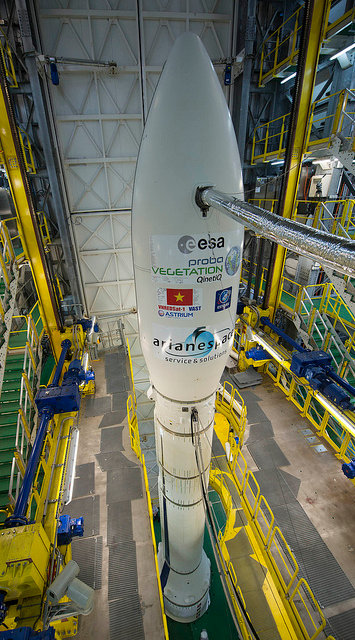 As the satellite communications industry has matured, it has become highly cost-competitive. There is constant pressure to lower costs while improving services to end-users. In particular, the market for High Throughput Satellites is growing, as is interest in large low earth orbit (LEO) constellations with hundreds of satellites delivering broadband services.
As the satellite communications industry has matured, it has become highly cost-competitive. There is constant pressure to lower costs while improving services to end-users. In particular, the market for High Throughput Satellites is growing, as is interest in large low earth orbit (LEO) constellations with hundreds of satellites delivering broadband services.
In this landscape, ESA is supporting the development of Vega, a small, solid-fuelled launcher for satellites ranging from 300 kg to 2500 kg in mass, depending on the type and altitude of the orbit required by customers. The Vega launcher has now been used for five missions, with a sixth, the launch of the Lisa Pathfinder, planned for the end of November.
The VECEP programme, which was approved at the 2012 Ministerial Council, will see a consolidated version of Vega introduced during the second half of the decade. This should increase the robustness and competitiveness of the launcher and reduce recurring costs and dependency on non-European sources.
Could Vega become a viable launcher option in the steadily evolving commercial satcoms sector? That is a question that was addressed in two recent parallel studies, Analysis of Vega for telecommunications missions, that were funded by ESA under ARTES 1.
The first study was undertaken by German satellite manufacturer OHB. The second was authored by ELV, the prime contractor of Vega. Both studies investigated whether the use of Vega for missions could offer a competitive advantage for different satcom stakeholders.
The authors of the studies identified the performance targets that future versions of the Vega launcher (Vega-C, Vega-E) would need to be able to meet to satisfy operators' commercial requirements for launching small telecommunication satellites in GEO, LEO and MEO. It was concluded that moving towards full electric propulsion (full-EP) satellite concepts could make the Vega very attractive economically.
“In the growing LEO market, Vega is already competitive and will quickly become a reference launch system, because of its flexibility, availability and reliability. It is well suited for small satellite constellation deployment, particularly for shared launches, due to its very competitive cost structure. The study has been instrumental to define how to make Vega attractive for the highly competitive satcoms market in the future,” said Claudio Milana, one of the authors of the ELV study.
“Building technologically feasible and economically viable telecommunications satellites is a task constrained by many parameters,” said OHB’s Jan-Christian Meyer, who participated in the OHB study. “Our research indicated what is currently feasible with today's technology and has given us a very clear roadmap of what still needs to be done at the launcher and satellite level”.
Under the ARTES 33 programme, OHB is currently developing, for its SmallGEO product line, an all-electric satellite configuration, named Electra, which has successfully completed the preliminary definition stage. “With Electra, OHB will meet customer demands today, not too far from where the Vega for telecommunications study wants to go in the future,” Meyer said.
"As this study shows, ARTES 1 plays a key role in identifying the future requirements of the space industries of our Member States, and developing long-term strategies that support the Member States' socio-economic goals," said Andrew James Murrell, Head of the ARTES 1 Programme Management and ARTES 5.1 Programme Preparation Office.




